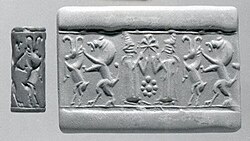Dingir

Dingir ⟨𒀭⟩, usually
The Sumerian cuneiform sign by itself was originally an
The concept of divinity in Sumerian is closely associated with the heavens, as is evident from the fact that the cuneiform sign doubles as the ideogram for 'sky', and that its original shape is the picture of a star. The eight-pointed star was a chief symbol for the goddess Inanna. The original association of 'divinity' is thus with 'bright' or 'shining' hierophanies in the sky.
Cuneiform sign
Sumerian
The Sumerian sign DIĜIR ⟨𒀭⟩ originated as a star-shaped ideogram indicating a god in general, or the Sumerian god
The plural of diĝir can be diĝir-diĝir, among others. ![]()
![]()
Assyrian
- the Akkadian nominal stem il- meaning 'god' or 'goddess', derived from the Semitic ʾil-
- the god Anum (An)
- the Akkadian word šamû, meaning 'sky'
- the syllables an and il (from the Akkadian word god: An or Il, or from gods with these names)
- a preposition meaning "at" or "to"
- a determinative indicating that the following word is the name of a god
According to one interpretation, DINGIR could also refer to a priest or priestess although there are other Akkadian words ēnu and ēntu that are also translated priest and priestess. For example, nin-dingir (lady divine) meant a priestess who received foodstuffs at the temple of Enki in the city of Eridu.[4]
Encoding
The cuneiform sign was encoded in Unicode 5.0 under its name AN at the code point U+1202D 𒀭.
See also
- Divine name
- Mesopotamian mythology
- Anunnaki
Notes
References
- Edzard, Dietz Otto (2003). Sumerian Grammar. Handbook of Oriental Studies. Vol. 71. Atlanta: Society of Biblical Literature. ISBN 1-58983-252-3.
- Hayes, John L. (2000). A Manual of Sumerian Grammar and Texts. Aids and Research Tools in Ancient Near Eastern Studies (Second revised ed.). Malibu: Undena Publications. ISBN 0-89003-508-1.

